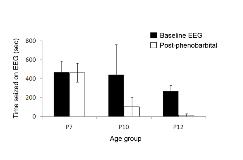Quantitative video-EEG in a mouse model of neonatal ischemic-seizures: age-dependent efficacy of phenobarbital
Abstract number :
2.376
Submission category :
18. Late Breakers
Year :
2010
Submission ID :
13433
Source :
www.aesnet.org
Presentation date :
12/3/2010 12:00:00 AM
Published date :
Dec 2, 2010, 06:00 AM
Authors :
S. D. Kadam, G. J. Markowitz, S. K. Kang, A. M. Comi, F. E. Dudek, M. V. Johnston
Rationale: Ischemia in the immature brain is an important cause of refractory seizures. The exact timing of neonatal stroke onset is usually unclear and the diagnosis delayed until presentation with seizures a few to several hours later. Neonatal electrographic seizures often respond poorly to anticonvulsant drugs with a GABAA agonist mechanism of action. To investigate the anti-seizure efficacy of the first line anticonvulsant and GABAA-agonist phenobarbital on neonatal ischemic-seizures, we utilized unilateral carotid-ligation to produce ischemia and acute ischemic-seizures in postnatal day 7, 10 and 12 CD1 mice.Methods: Unilateral ischemia was induced by right carotid permanent-ligation. Acute ischemic post-stroke seizures were recorded using video-EEG in P7, 10 and 12 pups with sub-dermal scalp electrodes. After recording baseline post-stroke video-EEGs each pup received IP injections of 25mg/kg loading doses of sodium phenobarbital. Quantitative video-EEG analysis was done for the same duration of pre- and post-treatment EEGs using Pinnacle (Pinnacle technology Inc., KS) seizure scoring and Insight software (Persyst development corp., AZ). Post-ligation brains were examined for stroke-injury and along with age-matched na ve brains processed for immunohistochemical and western blot analysis evaluating expression profiles of the adult-form electroneutral chloride co-transporter KCC2.Results: Phenobarbital was an efficacious anti-seizure agent in P12 stroke-injured pups with robust ischemic seizures. At P12 phenobarbital stopped both the occurrence of behavioral seizures as well as the associated electrographic seizures that were quantified as time spent seizing (n=6) on EEG. Power spectrum analyses in the 0.5-32Hz range were also significantly reduced after treatment in the seizing P12 pups. However, at P7 phenobarbital failed to stop both electrographic and behavioral ischemic seizures (n=10). Post-treatment EEG power spectrums were marginally lowered and associated with lower spike-wave amplitudes on the EEG traces. The duration and counts of seizure events, however, remained unaffected. Partial anticonvulsant efficacy was observed at P10 (n=2) for both time spent seizing and reduction in EEG power. An age-dependent increase in KCC2 expression was established in the maturing CD1 mouse brain from postnatal ages P3 to P22.Conclusions: Anticonvulsant efficacy of phenobarbital for treating acute ischemic-seizures was age-dependent in postnatal pups. Age-dependent increase in the hyperpolarizing effects of the GABAA agonist may depend on the increasing KCC2 expression profile detected in the maturing CD1 mouse brains. Inefficacious anticonvulsant action at P7 and partial efficacy noted at P10 indicate that ischemia at postnatal ages between P7- P10 may best model neonatal ischemic-seizures in CD1 mice. Establishing this in-vivo model of ischemic-seizures to mimic the clinical condition and response to current first-line treatment protocols will help test novel anti-seizure drugs and therapeutic interventions for evidence-based management of acquired neonatal seizures.
